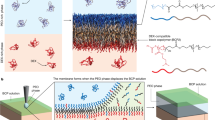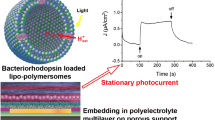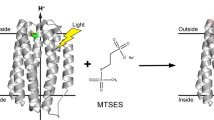Abstract
Block copolymer-based membranes can be functionalized with energy transducing proteins to reveal a versatile family of nanoscale materials. Our work has demonstrated the fabrication of protein-functionalized ABA triblock copolymer nanovesicles that possess a broad applicability towards areas like biosensing and energy production. ABA triblock copolymers possess certain advantages over lipid systems. For example, they can mimic biomembrane environments necessary for membrane protein refolding in a single chain (hydrophilic(A)- hydrophobic(B)-hydrophilic(A)), enabling large-area membrane fabrication using methods like Langmuir-Blodgett (LB) deposition. Furthermore, the robustness of the polymer molecules/structure result in spontaneous and rapid protein-functionalized nano-vesicle formation that retains structure as well as protein functionality for up to several months, compared to one to two weeks for the lipid systems (e.g. POPC). The membrane protein, Bacteriorhodopsin (BR), found in Halobacterium Halobium, is a light-actuated proton pump that develops gradients towards the demonstration of coupled functionality with other membrane proteins, such as the production of electricity through Bacteriorhodopsin activity-dependent reversal of Cytochrome C Oxidase (COX), found in Rhodobacter Sphaeroides. Protein-functionalized materials have the exciting potential of serving as the core technology behind a series of fieldable devices that are driven completely by biomolecules.
Similar content being viewed by others
References
J. L. Spudich, R.A. Bogolmolni, “The mechanism of color discrimination by a bacterial sensory,” Nature vol. 312, 509–513, (1984).
J.L. Spudich R.A. Bogolmolni, “Sensory rhodopsin in halobacteria,” Annu. Rev. Biophys. Chem., vol.17, 193–215, (1984).
G. Steinberg, N. Friedman, M. Sheves, M. Ottolenghi, “Isomer composition, and spectra at the dark and light adapted forms at artificial bacteriorhodopsin,” Photochem. Photobiol., vol.54, 969–976, (1991).
W. Stoeckenius, “From membrane structure to bacteriorhodopsin,” J. Membr. Biol, vol. 139, 139–148, (1994).
W. Meier, C. Nardin, M. Winterhalter, “Reconstitution of Channel Proteins in (Polymerized) ABA Triblock Copolymer Membranes,” Angew. Chem. Int. Ed., vol. 39, pp 4599–4602, (1999).
M. Winterhalter, C. Hilty, S.M. Bezrukov, C. Nardin, W. Meier, D. Fournier, “Controlling Membrane Permeability with Bacterial Porins: Application to Encapsulated Enzymes.” Talanta 55:965–971, (2001).
C. Nardin, J. Widmer M. Winterhalter, W. Meier, “Amphiphilic Block Copolymer Nanocontainers as Bioreactors.” Eur. Phys. Journ. E. 4:403–410, (2001).
Y. Zhen, J. Qian, K. Follmann, T. Hayward, T. Nilsson, M. Dahn, Y. Hilmi, A.G. Hamer, J.P. Posler, S. Ferguson-Miller, Protein expression and purification 13, 326–336, (1998).
C. Nardin, M. Winterhalter, W. Meier, “Giant Free-Standing ABA Triblock Copolymer Membranes,” Langmuir vol.16, pp 7708–7712, (2000).
M. Winterhalter, K. Klotz, R. Benz, in Electromanipulation of Cells, edited by U. Zimmerman, G.A. Neil, CRC Press, Boca Raton, p.137,(1995).
D. Ho, B. Chu, J. Schmidt, E. Brooks, C.D. Montemagno, “Hybrid Protein/Polymer Biomimetic Membranes” accepted to IEEE Trans. Nanotechnology June, (2004).
H. Lee, D. Ho, J. Schmidt, C.D. Montemagno, “Reconstitution of energy converting proteins in biocompatible materials,” IEEE Proc. Nanotechnology, vol. 2, 733–736, (2003).
A. Hazard, C.D. Montemagno, “Improved puri.cation for thermophilic F1F0 ATP synthase using n-dodecyl b-D-maltoside,” Arch. Biochem. Biophys., vol. 407, 117–124, (2002).
J. Gau, E. Lan, B. Dunn. C.M. Ho, J. Woo,”A MEMS based amperometric detector for E. coli bacteria using self-assembled monolayers,” Biosens. Bioelec., vol. 16, pp. 745–755, (2001).
Acknowledgments
The authors would like to thank Na Li for assistance with cyclic voltammetry and Hyojick Choi for TEM assistance.
Author information
Authors and Affiliations
Rights and permissions
About this article
Cite this article
Ho, D., Chu, B., Lee, H. et al. Block Copolymer-Based Biomembranes Functionalized with Energy Transduction Proteins. MRS Online Proceedings Library 823, W11.8 (2004). https://doi.org/10.1557/PROC-823-W11.8
Published:
DOI: https://doi.org/10.1557/PROC-823-W11.8




